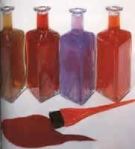Back2myroots: A place to share thoughts and grow idea's. B2MR
Choosing: The right colour line for your Salon: How would you go about it?
What is the right product for you? How do you get all the answer to make an informed choice or decision! With so many products on the market so many manufacturers how on earth do you decide what company what product to chose? This is a big decision and a huge out lay for any salon so you have to get it right.
Do you make a list? If so where do you start?
* Cost.
*Quality.
*Education support and training.
*Ammonia free.
*Herbal or organic.
*Reputation.
*Staff interest or approval.
*best deal at the time.
All quite valid points and all have merit to some degree. With so many manufactures all trying for the same market as wholesale or as distributor the profit and returns are very good. The goal of any distributor is to get the colour line they represent in to your salon. Most distributors will carry more than one colour line. They work every closely with the manufactures that they represent. Many work on the premiss that if they can get their colour line into your salon then the wet line and retail sales should follow. Incentives are offered such as free or reduced price back bar or display stands.maybe even some stylist products. all sounds really good. If you have never negotiated these point now you can!
Back to the question: How do you chose?
The above list may help make your own. I do think that the staff have to be onboard with this and commit to any truing that may be required. Do not go for a new colour line without any training. Poor results will follow. Collaboration between management and staff is essential.
I would suggest have a few companies put on demonstration nights to test the product and ask any valid question.Do distributors and manufactures do this yes they do they have trained educators to do this and work with the distributor. If they don't then they are not worth bothering with! If you already use a colour line but are looking to change this is usually because the staff are having issues with the product. Or a brand new product has come onto the market and it's the next got to have thing! New is good but sometimes new comes with teething issues so sit back and wait awhile!
Fact: When staff want change due to product issues 9 times out of 10 it's not the product! True it's so easy to blame a tube of colour when things go wrong normally one of the following.
* Poor deposit.
* Fading.
* Reds that don't hold.
*N series that cannot control warmth.
* Lack of general warmth control.
*Poor quality high lift shades. [normally relating when trying to go from level 6 to 10!] Da!!! not possible asking to lift to many levels not enough pigment control!
* Not enough choice of shades.
* Want Ammonia free.
Most sales rep's are trained to ask questions prior to starting to sell you a new colour line. They know how to draw the weaknesses of the colour line you use out. All colour line shave their strengths and their weaknesses. But if you and your staff are educated properly and use the product correctly these issues can be dealt with. All of the list above have nothing to do with the product! Do you know what it's to do with? Poor consultation.Poor assessment. Bad formulation. In other word the stylist or technician. Laziness. Poor training. or just good old not caring.
Dose quality play a part? Yes supported by re search and investment.
Of course it does. Do you get what you pay for! for the most part yes. Do they differ that much. Yes they do. Another list!
*Cream colour or oil based.
* Direct dye or none direct. partially or fully developed colour molecules.
* Organic or herbal. or other. Big issue this come shown to some technical understanding on chemistry.
*Ammonia Free. If yes then what drives the colour? need to know.
* Full range Permanent semi demi.options to colour balance.
* Is the N series calibrated to deal with warmth exposed at any given level?
Once you have researched and got your list of questions together now you can invite the different company representatives to come in do a demonstration and answer your questions. I do not promote individual colour lines or products If someone were to offer me a job as an educator then i might. Do i have favourites yes1 Would I share this with you if asked Yes! But only in one on one e-mail as response to a question.
The quality of products changes constantly new ones come and go. A few of the manufactures are committed to our industry and to supporting stylist and education for some it's just business in the salon or over the counter. My advise would be research look for the ones offering the best support education and training. If you do this you don;t have to change colour lines for any of the reason's above.Why because your using the best an dour staff have the very best training and support.
One last thing:
Some colour lines may seem cheap larger tubes mixing ratios are very important is it mix 1 part colour to 1 1/2 developer or 2 parts colour 1 part developer and the more pigment needed for a formulation normally indicates poorer quality of pigment in the tube. Salon waste is also very expensive measure colour weigh it keep good records eye balling it is wasteful and un professional.
Mike B2MR























